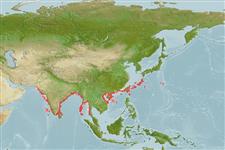Elasmobranchii (haaien en roggen) (sharks and rays) >
Carcharhiniformes (Ground sharks) >
Carcharhinidae (Requiem sharks)
Etymology: Glyphis: Tautonymous with Carcharias glyphis Müller & Henle 1839. (See ETYFish); gangeticus: -icus (Gr.) belonging to: Ganges River, India, where Müller and Henle mistakenly thought it occurred. (See ETYFish).
More on authors: Müller & Henle.
Environment: milieu / climate zone / depth range / distribution range
Ecologie
marien; zoet water; brak water demersaal; amfidroom (Ref. 51243). Tropical; 30°N - 8°N, 65°E - 143°E
Indo-West Pacific: north Indian Ocean, Indus River outside Karachi, Pakistan to Bangladesh, Myanmar, Thailand and Borneo.
Grootte / Gewicht / Leeftijd
Maturity: Lm ? range ? - ? cm
Max length : 204 cm TL mannelijk / geslacht onbekend; (Ref. 244)
Biology poorly known. But its minute eyes suggest that it may be adapted to turbid water with poor visibility, as in large tropical rivers and muddy estuaries. Newborn specimens are from 56 to 61 cm long. Viviparous (Ref. 50449). Its notoriety may have stemmed from its widespread confusion with C. leucas. But this species is potentially dangerous as well because of its size and large teeth, though its reputation as a man-eater is still unproven.
Levenscyclus en paargedrag
Maturiteit | Voortplanting | Paaien | Eieren | Fecunditeit | Larven
Viviparous, placental (Ref. 50449). Distinct pairing with embrace (Ref. 205).
Compagno, L.J.V., 1984. FAO Species Catalogue. Vol. 4. Sharks of the world. An annotated and illustrated catalogue of shark species known to date. Part 2 - Carcharhiniformes. FAO Fish. Synop. 125(4/2):251-655. Rome: FAO. (Ref. 244)
Status op de Rode Lijst van het IUCN (Ref. 130435)
Gevaar voor de mens
Traumatogenic
Gebruik door de mens
Visserij: visserij voor eigen gebruik
Meer informatie
Leeftijd/GrootteGroeiLengte-gewichtLengte-lengteLengtefrequentiesMorfometrieMorfologieLarvenLarvale populatiedynamiekRekruteringAbundantieBRUVS
ReferentiesAquacultuurAquacultuurprofielKweeklijnenGeneticaElectrophoresesErfelijkheidZiektesVerwerkingNutrientsMassaconversie
Tools
Speciale rapporten
Download XML
Internetbronnen
Estimates based on models
Preferred temperature (Ref.
123201): 24.6 - 28.1, mean 26.3 °C (based on 141 cells).
Fylogenetische diversiteitsindex (Ref.
82804): PD
50 = 0.5312 [Uniqueness, from 0.5 = low to 2.0 = high].
Bayesian length-weight: a=0.00468 (0.00218 - 0.01003), b=3.09 (2.92 - 3.26), in cm total length, based on LWR estimates for this (Sub)family-body shape (Ref.
93245).
Trofisch niveau (Ref.
69278): 4.2 ±0.7 se; based on size and trophs of closest relatives
Weerstandsvermogen (Ref.
120179): Zeer laag, minimale populatieverdubbelingstijd meer dan 14 jaar (Assuming Fec<10).
Fishing Vulnerability (Ref.
59153): Very high vulnerability (90 of 100).
